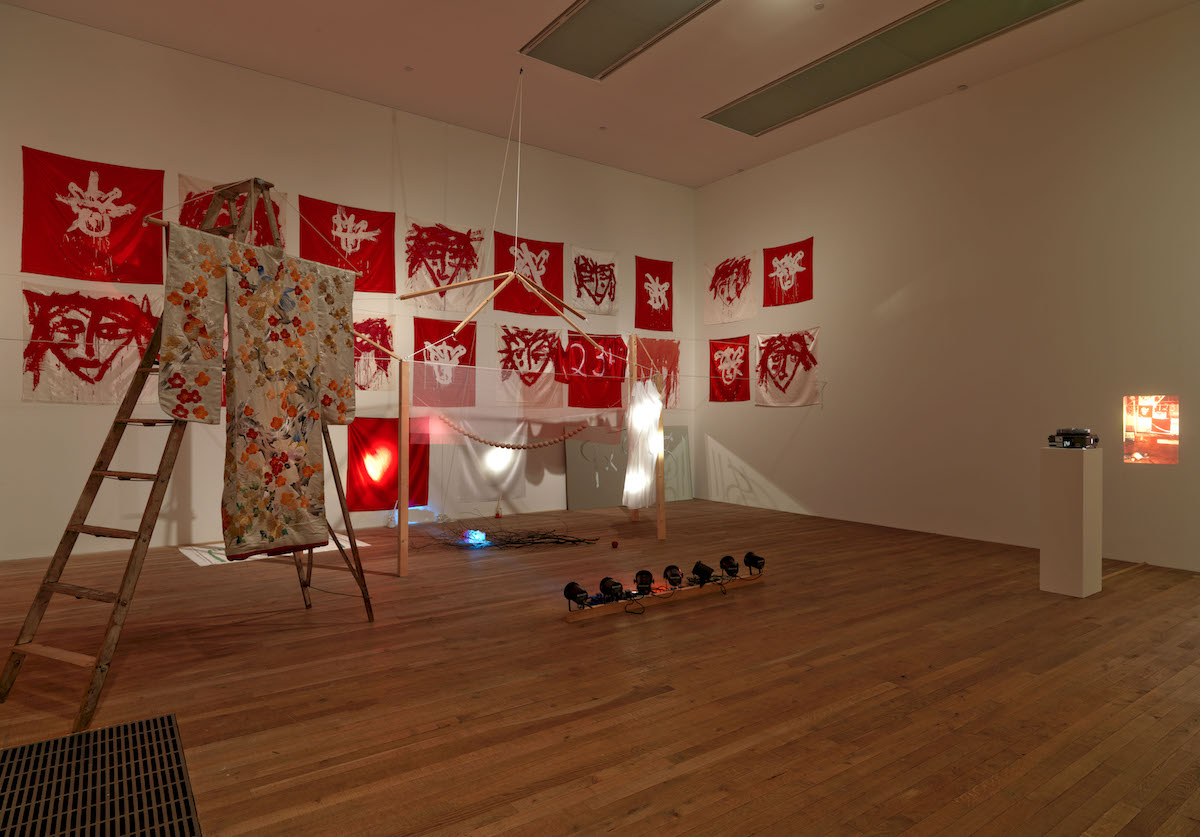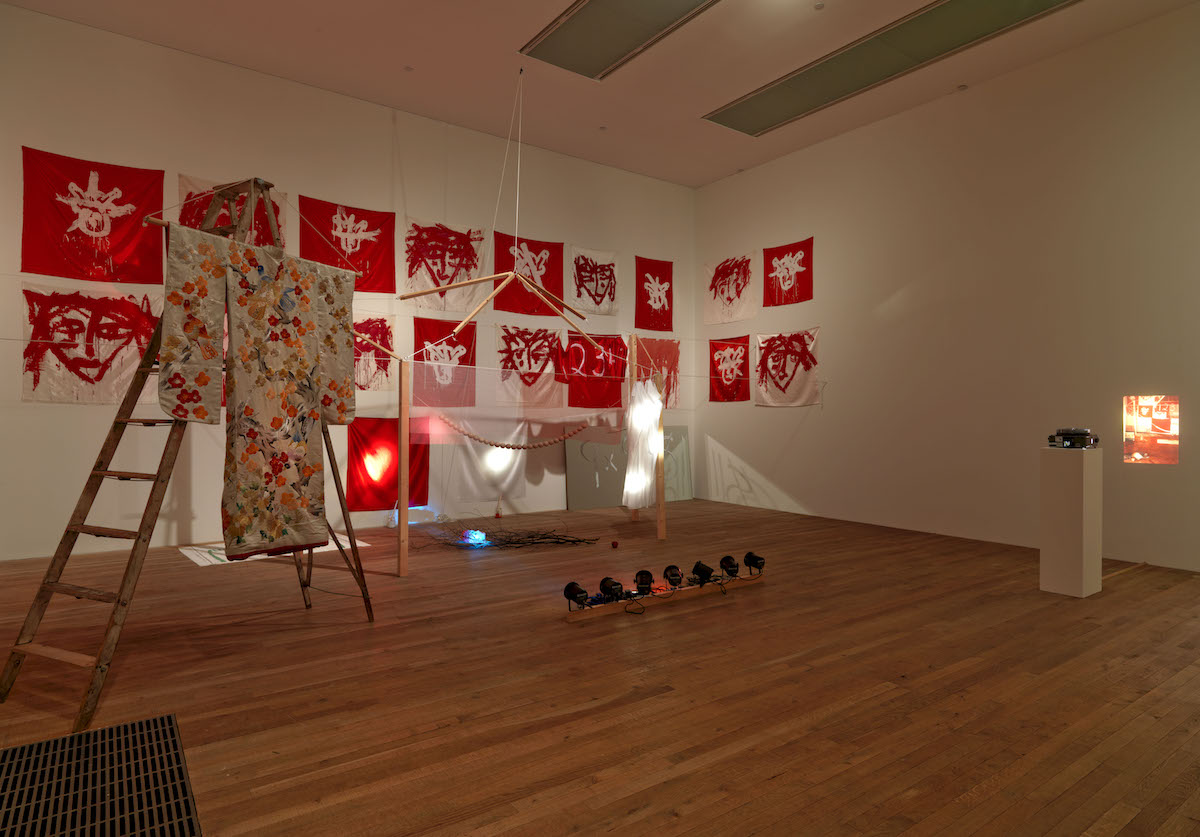[ad_1]

Joan Jonas, The Juniper Tree, 1976/94, 24 works on silk, acrylic paint, wooden structure, string of 29 wooden balls, ladder, kimono, mirror, glass jars, 78 slides, box and other materials. Installation view at Wilkinson Gallery, London, 2008.
©2018 JOAN JONAS/ARTISTS RIGHTS SOCIETY (ARS), NEW YORK/DACS, LONDON/PHOTO: COURTESY WILKINSON GALLERY, LONDON, AND PETER WHITE/TATE, PURCHASED, 2008
A Joan Jonas survey currently on view at Tate Modern in London brings together a vast range of works by the pioneering performance artist, whose work has tackled countless topics over the past half-century, from the male gaze to the relationship between humans and technology. While she has become known for her dense installations, which often include a combination of performance, video, and sculpture, there was a time when Jonas was less accustomed to making larger, more technically complex work. This week, we’ve pulled from our archives a review of Jonas’s 1976–77 exhibition at the Institute of Contemporary Art in Philadelphia. Reprinted from the April 1977 issue of ARTnews, it includes a look at her first-ever site-specific work, as well as some thoughts on her early video pieces. —Alex Greenberger
Excerpted from “Suspended in shadow”
By Ann Jarmusch
April 1977
Joan Jonas’ installation Stage Sets was shown at the Institute of Contemporary Art—a first, according to assistant director Michael A. Quigley, simply because Jonas had never before been asked to create an environment for a specific space. Using simple materials such as paper, wood, metal and mirrors, Jonas filled this cavernous two-story with architectural fragments of her own design: unconnected, wood-framed, brown paper “walls” and peaked “roof”; a hexagonal velvet-lined booth with a surprise entrance facing a gallery corner; six tall, slender metal cones—almost a Jonas trademark—with soft circles of light beaming from their open ends to warm the slate floor; and a large industrial-looking metal ring in a nearby corner. A row of six pine stools with high seats and felt-covered backrests directly confronted half a dozen small oval mirrors hung very low and at a distance on the opposite wall. Drawings of elementary geometric shapes, plus lines that seemingly acted upon then, were done directly on the gallery walls. Many of the environment’s pieces were suspended in this shadowy, blue-lit setting. The installation conjured up mental associations with both Japanese architecture (perhaps because of the use of wood and paper and purity of forms) and secret artifacts from primitive cultures.
During the exhibition Jonas gave a Philadelphia premiere of a performance of Mirage, as well as enacting her ICA-commissioned performance for children, The Juniper Tree. Both took place in the Stage Sets environment. However, because Mirage had been created for the Anthology Film Archives in New York and first performed elsewhere, it related less to the ICA installation than did The Juniper Tree, designed for the space. Assisted at times by The Bird and The Dirt Arts Collaborative member Mary Klaus, Jonas flashed mirrors at the audience, dragged rocks across the floor beneath the hanging cones, drew with chalk on a blackboard and tabletop, perched on the television showing her video images, argued in gibberish, and laughed into a freestanding cone, among other enigmatic activities.
The Juniper Tree was based on the Brothers Grimm tale, which was read throughout the performance by poet Susan Howe; unlike Mirage it had a fantastic plot. Jonas’ own gift for splendid and startling imagery placed a singing board (played by one of three additional performers) at the top of a wooden ladder representing the tree. As the father in the story climbed the tree his jacket, made of tiny mirrors, reflected a flurry of light specks on the ceiling, suggesting a snowstorm. Jonas in various roles gave dramatic birth to a child (played by a live rabbit) and sat on one of the pine stools to knit twine with nine-foot “knitting needles.”
In addition to the performances, four Jonas films were screened one afternoon and nearly a dozen of her videotapes were shown daily in a mock livingroom setting most notable for its green velvet, lima-bean-shaped sofa and garish vase filled with peacock feathers and plastic flowers.
[ad_2]
Source link

